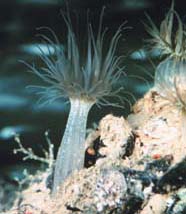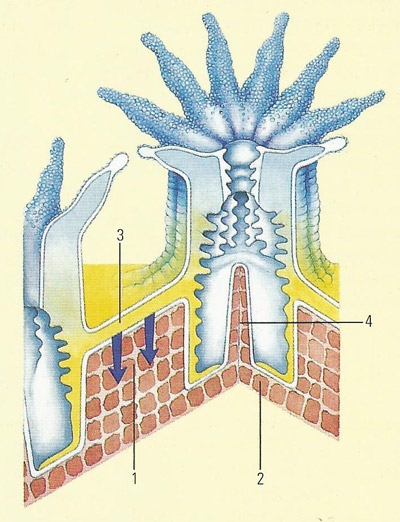polyp

Photo of a cnidarian polyp.

Stony coral polyps obtain support from a mineralized, cup-like theca (1), which is secreted by the animal. The theca, which is composed of minerals absorbed from surrounding seawater, anchors the polyp to the basal structure (2), and to its neighbors in the colony via connecting plates (3). All of the mineralization occurs outside the body, although mineral spikes (4) may provide additional support.
In zoology, a polyp is a sedentary, column-shaped form of cnidarian. Polyps may be solitary individuals or members of a cnidarian colony. They consist of a cylindrical trunk, fixed at one end, with a mouth at the other end, surrounded by a ring of tentacles.
Many polyps reproduce by budding, and may form colonies, as in the case of corals). Some reproduce sexually, fertilized eggs giving rise to new polyps, as in the case of Hydra and sea anemones. Others do not reproduce sexually, but produce medusae by budding and these reproduce sexually, their fertilized eggs giving rise to new polyps, as in the case of jellyfish.
In medicine, a polyp is a growth, usually benign, protruding from a mucous membrane. Polyps are commonly found in the nose and sinuses, giving rise to obstruction, chronic infection, and discharge. They are often present in patients with allergic rhinitis, in whom they may develop in response to long-term antigenic stimulation. Other sites of occurrence include the ear, the stomach, and the colon, where they may eventually become malignant.
In medical science, juvenile polyps occur in the intestine (usually colon or rectum) of infants or young people; sometimes they are multiple (juvenile polyposis). In the latter form there is a risk (25% of cases) but most juvenile polyps are benign.
Polyps are usually removed surgically.


